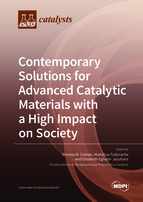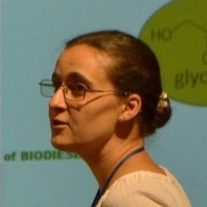Contemporary Solutions for Advanced Catalytic Materials with a High Impact on Society
A special issue of Catalysts (ISSN 2073-4344). This special issue belongs to the section "Catalytic Materials".
Deadline for manuscript submissions: closed (1 August 2022) | Viewed by 27972
Special Issue Editors
Interests: heterogeneous catalysis; asymmetric catalysis; organocatalysis; green chemistry; biomass valorization
Special Issues, Collections and Topics in MDPI journals
Interests: application of enzymes for the environment monitorization, clinical analysis and industrial synthesis of added-value products; enzyme/whole cell catalysis; enzyme immobilization; biomass valorization
Special Issues, Collections and Topics in MDPI journals
Interests: biocatalysis; enantiopure biologically active compounds; chiral chromatography; natural product chemistry
Special Issues, Collections and Topics in MDPI journals
Special Issue Information
Dear Colleagues,
The progress of contemporary society is basely related to the area of advanced materials, using novel and sophisticated designs and involving high-performance technology and material synthesis. Most advanced materials are designed for catalytic applications to satisfy the continuous requirements of our modern life, which is increasingly dependent on the catalysis. Therefore, advanced catalytic materials offer new solutions for healthcare (pharmaceuticals and therapeutics), energy (petrochemicals), new materials (polymers), transport (catalytic convertors), and the environment (water/air quality, renewable and bioproduced materials).
The main aim of this Special Issue is to highlight the contribution of advanced catalytic materials in the evolution of contemporary society, delivering practical and useful solutions with a positive societal, economic, and environmental impact. Therefore, several aspects will be considered related to the synthesis, characterization, and applications of the advanced catalytic materials. Original research papers and reviews providing new insights into the area of advanced catalytic materials are welcome.
Prof. Dr. Simona M. Coman
Dr. Madalina Tudorache
Dr. Elisabeth Egholm Jacobsen
Guest Editors
Manuscript Submission Information
Manuscripts should be submitted online at www.mdpi.com by registering and logging in to this website. Once you are registered, click here to go to the submission form. Manuscripts can be submitted until the deadline. All submissions that pass pre-check are peer-reviewed. Accepted papers will be published continuously in the journal (as soon as accepted) and will be listed together on the special issue website. Research articles, review articles as well as short communications are invited. For planned papers, a title and short abstract (about 100 words) can be sent to the Editorial Office for announcement on this website.
Submitted manuscripts should not have been published previously, nor be under consideration for publication elsewhere (except conference proceedings papers). All manuscripts are thoroughly refereed through a single-blind peer-review process. A guide for authors and other relevant information for submission of manuscripts is available on the Instructions for Authors page. Catalysts is an international peer-reviewed open access monthly journal published by MDPI.
Please visit the Instructions for Authors page before submitting a manuscript. The Article Processing Charge (APC) for publication in this open access journal is 2700 CHF (Swiss Francs). Submitted papers should be well formatted and use good English. Authors may use MDPI's English editing service prior to publication or during author revisions.
Keywords
- Advanced catalytic materials
- Nanomaterials with catalytic properties
- Catalytic materials from biomass
- Novel approaches for the synthesis of advanced catalytic materials
- New technologies for the characterization of advanced catalytic materials
- Green catalysis
- Biocatalysis
- Photocatalysis
- Environmental catalysis








